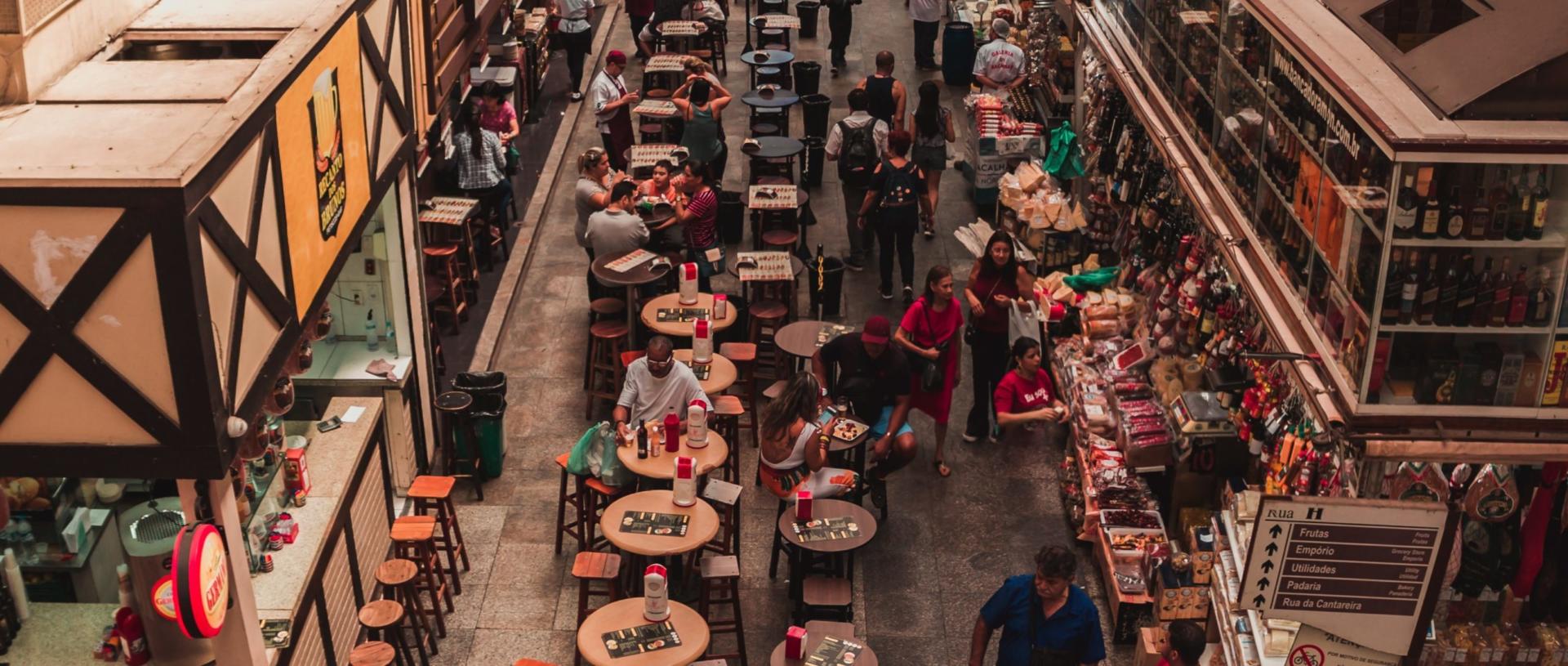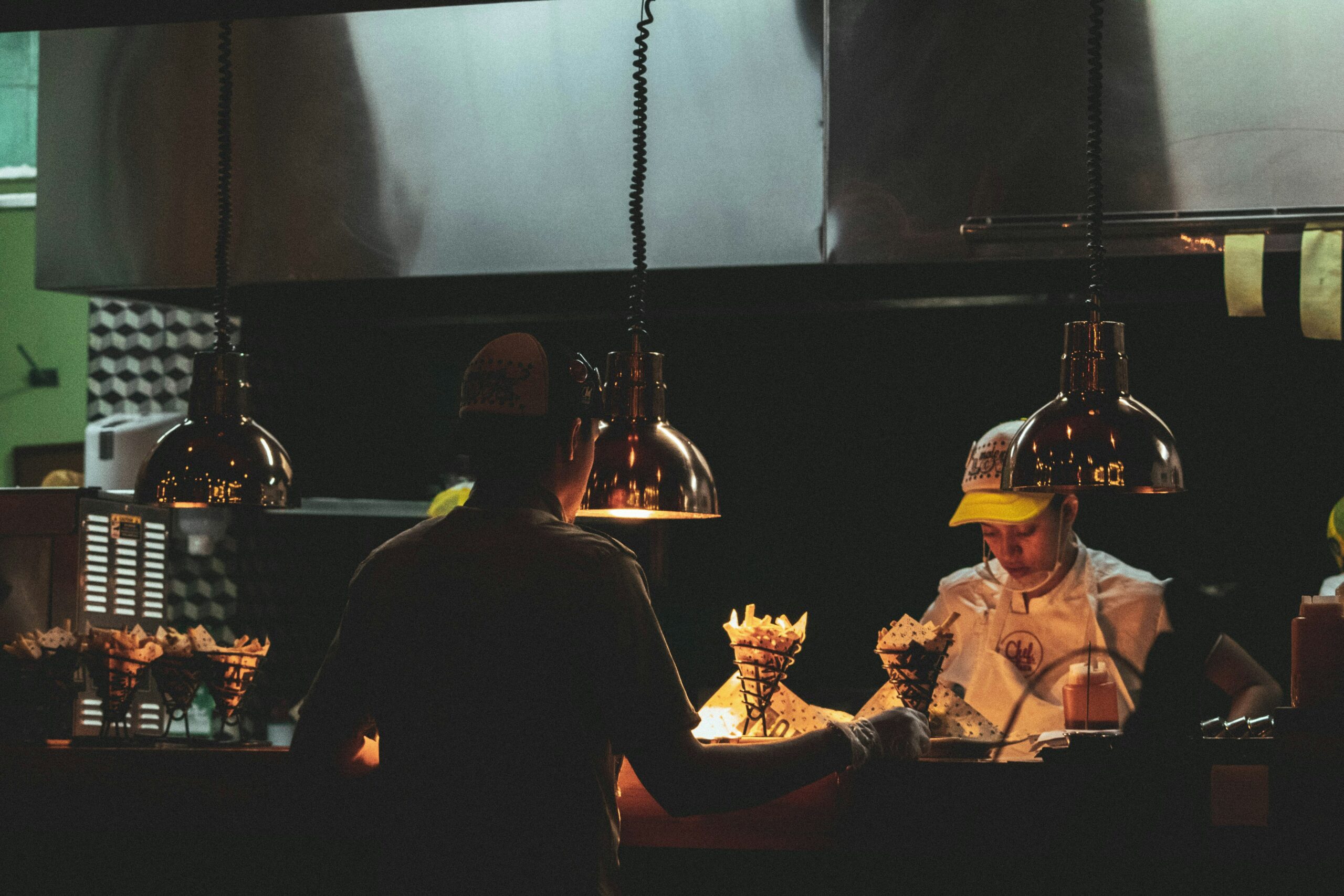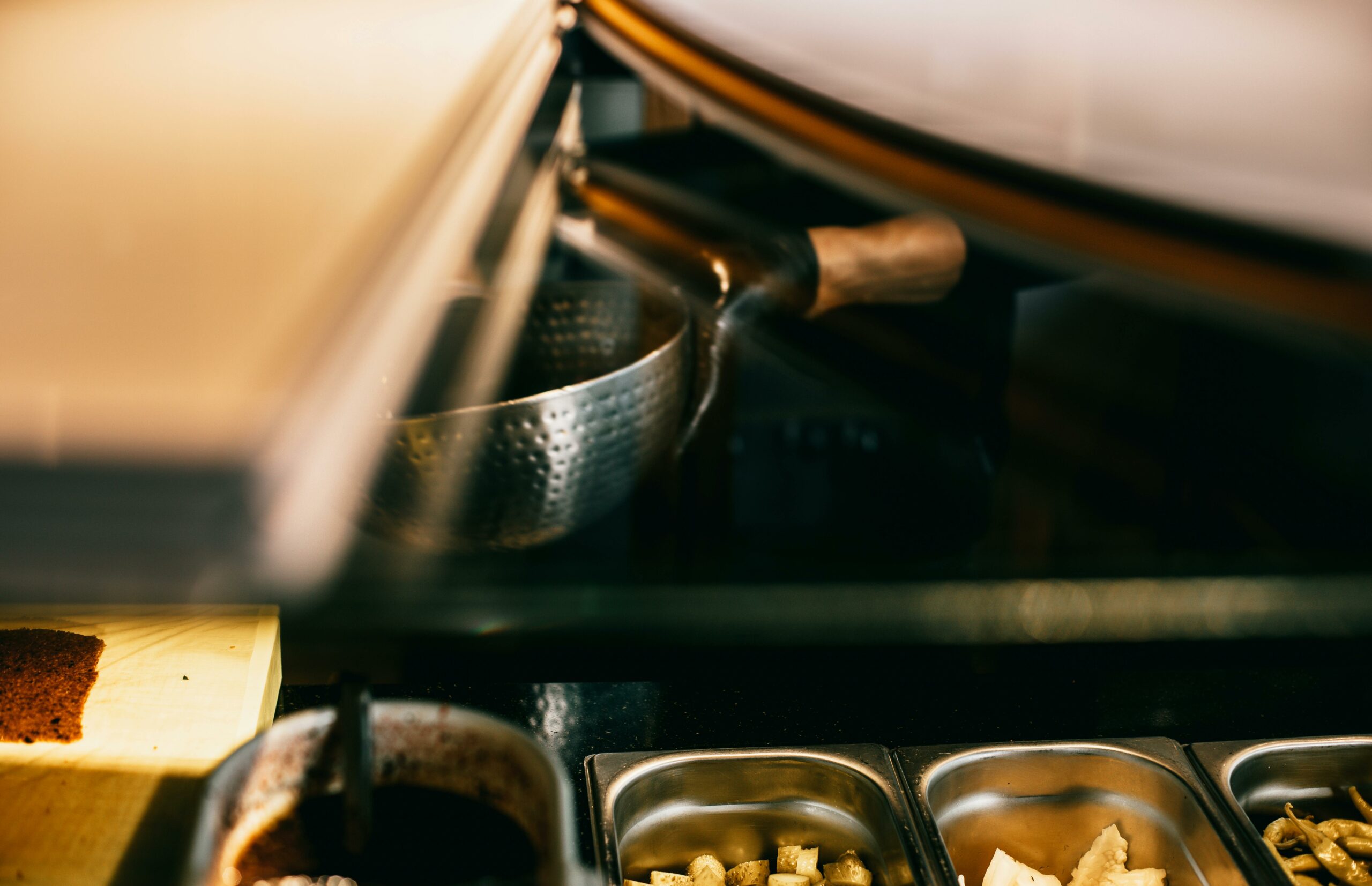Dark kitchens, food courts, takeaways: which models to choose in 2025?
June 30, 2025
Dark kitchen, food courtthree formats that will reshape the food service industry in 2025.
The aim is to get straight to the point: produce quickly, sell efficiently and meet the needs of an increasingly mobile and connected customer base.
On the other hand, the context also calls for a change of model. Rents are rising, staff are scarce, margins are tightening. Above all, demand has shifted. Out-of-home sales (delivery, click & collect) now occupies a central place in the activities of many establishments.
So which model should you choose to stay profitable, agile and competitive?
In this article, we review the advantages, limitations and best practices of these three formats, to help you choose the one that best suits your project and site constraints.
Why these models are essential in 2025
Pressure on costs: rents, staff, m² profitability
Opening a classic restaurant requires more and more investment. Square footage is expensive, especially in city centers. Qualified staff are in short supply. And fixed costs are a heavy burden, especially when the room is empty.
In this context, it's difficult to run a venue for lunch and dinner, 7 days a week, without sacrificing margins. Lighter models are therefore gaining the upper hand: dark kitchens without rooms, shared food courts, takeaways without service.
Less surface area, more flexibility and optimized loads. And above all, the ability to run the kitchen continuously, without depending on the fill rate.
The rise of off-premises (delivery, takeaway)
At the same time, customer habits have evolved. The proportion of sales made outside our premises has exploded in recent years. Delivery, click & collect, pick-up at the counter: today, a significant proportion of sales are generated without table service.
It's no longer just for big cities or young professionals. It's used by everyone: busy parents, telecommuting employees, tourists passing through.
Platforms have played a role in this evolution, but more and more restaurateurs are looking to regain control by developing their own channels.
More mobile, more connected and, above all, more volatile customers
Habits have changed. You no longer choose a restaurant, you choose a craving. And we want it fast. It doesn't matter where, as long as it's convenient, reliable and at the right price.
Loyalty, on the other hand, is no longer based on a smile in the room. It is built elsewhere: in the ordering experience, in follow-up, in personalized programs.
Models that know how to capture this attention (and hold it) do better. Provided you're equipped to do so.
Dark kitchen: producing more with fewer constraints
The dark kitchen is based on a simple principle: cook to sell without hosting. No room, no service. Customers don't walk through the door; everything is delivered or collected.
Some kitchens are home to a single brand, others to several, often designed for different uses (burgers, salads, bowls, etc.). This model can be managed in-house or via a third party who rents out shared spaces.
On the production side, everything is organized for greater efficiency. Orders received via platforms, timed shipments, small but focused teams.
The aim: to serve as many dishes as possible in as little space as possible.
The format's advantages: scalability, rapid testing and reduced investment
The main advantage of a dark kitchen is its flexibility. There's no need to look for visible premises, or finance the fitting-out of a room.
You can :
✔ test a new offer without changing your entire organization,,
✔ launch several brands from a single production point,
✔ quickly adjust your schedules, staff or sales channels.
It's also easy to duplicate. Once your concept is up and running, you can open a second kitchen elsewhere, without having to rethink everything.
Limits to be anticipated: dependence on platforms and low customer retention
The downside is that you're often dependent on delivery platforms. Uber Eats, Deliveroo and others bring you visibility, but take a high commission and retain control over customer relations.
You get a volume, but you lose the data.
Unless you set up a dedicated solution in parallel.
"With Obypay's dark kitchen solution, you can manage your orders directly, retrieve customer data and automate reminders. This is what allows you to regain control over loyalty without giving up the volumes brought by the platforms."What makes all the difference
For whom, for what? (densely populated areas, dominant delivery, agile brands)
The dark kitchen remains a demanding model, but relevant if you are :
✔ located in an urban area, with real delivery potential,
✔ able to produce fast in a confined space,
✔ comfortable with test & learn (new cards, new brands),
✔ equipped with appropriate management tools.
It's a good way to get started at lower cost, to develop an existing business or to multiply brands in a shared space. Provided you're not flying blind.
➜ Discover Obypay's Dark Kitchen solution

Food Court: pooling for greater profitability
A food court is a shared space where several brands offer their own cuisine, concept and menu, while sharing the essentials: room, equipment and services.
Very present in shopping malls, railway stations and leisure areas, this format is seductive for its diversity and lively atmosphere.
On the management side, it reduces costs while increasing visibility.
The advantages of the format: synergy, diversity and profitability
What you gain is strength, without having to take on everything alone:
✔ a common room for all = fewer square meters to finance,
✔ a varied offer = more chances of capturing flows,
✔ an attractive location = ideal for welcoming families, groups and undecided customers,
✔ shared expenses: security, housekeeping, communication, entertainment...
For customers, it's practical: everyone can choose what they want, even with several people, without making compromises. For you, it's the assurance of a high-traffic location, without having to carry the whole project on your own.
Limits to be anticipated: multi-brand management and operational complexity
The strength of the food court lies in its diversity, but this is also what complicates management. You have to juggle several brands, several order paths and several teams.
Without the right tools, things get messy:
➜ multiple queues,
➜ payment at various locations,
➜ no inter-brand loyalty possible,
➜ difficulty in clearly tracking the performance of each brand.
"With the Obypay solution for food courts, you can centralize orders, unify payment (same basket, same receipt), and automatically distribute sales between brands. You can also set up a common loyalty program and retrieve customer data for each brand. That's what makes it possible to pool without losing control."What makes all the difference
For whom, for what? (real estate companies, franchises, multi-brand concepts)
The food court works well if :
✔ you manage several brands and are looking to mutualize costs,
✔ you are a real estate company or a site manager with flows to optimize,
✔ you want to offer a lively, modular venue, designed for on-the-spot consumption and take-away,
✔ you need solid tools to centralize management without losing legibility.
This format is ideal for high-traffic areas, retail parks and train stations, as well as lifestyle and event venues.
The key is to have a clear structure and a well thought-out customer journey.
Takeaway 2.0: a channel that's easy to develop
Takeaway is the simplest format to set up, but it has evolved considerably. It's a far cry from the ticket scribbled at the counter, the phone wedged between shoulder and ear.
Today, it's a sales channel in its own right, deserving the same tools and attention as room service or delivery.
The advantages of the format: margin, control, fluid flow
The big advantage is that you work directly with us. No platform commission, no external dependency.
✔ you use your own control channel,
✔ you control your rates, your promos, your production times,
✔ you get the customer data,
✔ you offer a fast, modern, frictionless route.
What's more, you can operate your kitchen at 100 %, even outside peak periods. Take-away allows you to smooth out activity, without having to fill a room.
Limits to be anticipated: organization and clarity of the customer journey
This model relies entirely on your ability to manage a fluid journey.
If the customer orders online and still waits 20 minutes on site, he's out of luck.
If the menu isn't clear, if the payment system glitches, if he doesn't understand where to pick up his order... he won't come back.
So you need tools that hold up, but you also need to be organized in the kitchen.
"With Obypay, you can integrate takeaway ordering with your checkout, track flows in real time, offer a variety of payment options and link everything to your loyalty program. The customer saves time, you gain efficiency."What makes all the difference
For whom, for what (independent restaurateurs, chains, high-traffic areas)
Click & Collect is accessible to all, but particularly useful if :
✔ you have a kitchen already in place,
✔ you're looking to expand your sales without opening a venue,
✔ you want to reduce platform dependency,
✔ you have a clientele that is office-based, passing through or in a hurry,
✔ you want to build a customer base solid.
It's a good way of digitizing your restaurant, testing new opening hours or smoothing out your business. And with the right tools, it's also a great way to keep customers coming back, without them having to sit in the dining room.
Hybrid models: towards a new standard?
The line between dark kitchen, food court and takeaway is becoming blurred. More and more players are mixing formats to gain flexibility and adapt to their constraints.
➜ A dark kitchen with a small counter for l'emporté.
➜ A food court that also offers delivery.
➜ A classic restaurant launches a virtual brand to diversify sales.
What counts is no longer the single model. It's the ability to adjust the cursor according to location, time of day and target audience.
Why mix formats? To sell more, without complicating operations
Crossing approaches enables :
✔ diversify its sales channels (on-site, delivery, takeaway),
✔ make full use of existing facilities (kitchen, staff, premises),
✔ adapt to flows without changing structure,
✔ testing concepts without starting from scratch.
But beware: more formats = more management complexity. And more points of friction if not thought through together.
What this means in terms of management and tools
When a customer can order from a kiosk for several banners, pick up part of the order on the spot and have the rest delivered... everything has to follow.
Cash desk, production, signage, payments, loyalty, SERVICE Everything has to run smoothly, even in a multi-brand or multi-channel environment. Without a central tool, things quickly go off the rails.
With an all-in-one solution, you can manage :
✔ several brands on a single interface,
✔ crossed customer paths (click & collect, room, delivery),
✔ a single, unified, usable customer database,
✔ shared loyalty, even between different brands.
This is what makes it possible for a food court to offer multi-brand basket without the hassle. Or for a classic restaurant to launch a virtual brand without duplicating everything.
Need a hand framing your model?
Whether you opt for a dark kitchen, a food court or a hybrid format, the challenge remains the same: to run a profitable, fluid model aligned with your resources.
To do this, you need a reliable base: centralized orders, a usable customer database, a coherent loyalty program and tools that communicate automatically.
Obypay can support you in all these formats, with concrete solutions designed for foodservice 2.0.
➜ Do you have a project or questions? Let's discuss it!












